Looking Back and Looking Forward
Teamsters Joint Council 7 celebrated its first century in 2007. In the eastern and northern part of California and Northern Nevada, Joint Council 38 celebrated its 80th year at the same time. Three years after those celebrations, the two councils merged to become a powerhouse among Joint Councils. Changes at the leadership level of Joint Council 7 marked an auspicious moment to look back on all that was accomplished under the leadership of our former Joint Council President, Rome Aloise. And to look forward as well, with the leadership of newly-elected President Jason Rabinowitz.
2010 — Getting together
In 2010, when Rome Aloise took over as President, Teamsters in Northern California were divided. In the Bay Area and on the coast, Teamsters were part of Joint Council 7. Local unions in the Central Valley, the northern part of the state, and Reno were all part of Joint Council 38. Understanding there is power numbers, Rome led the merger of the two Joint Councils into Joint Council 7, uniting more than 100,000 Teamsters from Bakersfield up to the Oregon border and Reno under one banner. Overnight, Joint Council 7 became one of the largest Teamster organizations in North America, and one of the largest labor organizations in California. This meant more resources to better represent our members and grow the union through new worker organizing.
Joint Council 7 was quick to flex its new muscles, and in the past eight years we’ve built one of the largest organizing, political, and representational programs in Teamster history. What have we accomplished?
We’ve organized nearly 20,000 new members into the Teamsters.
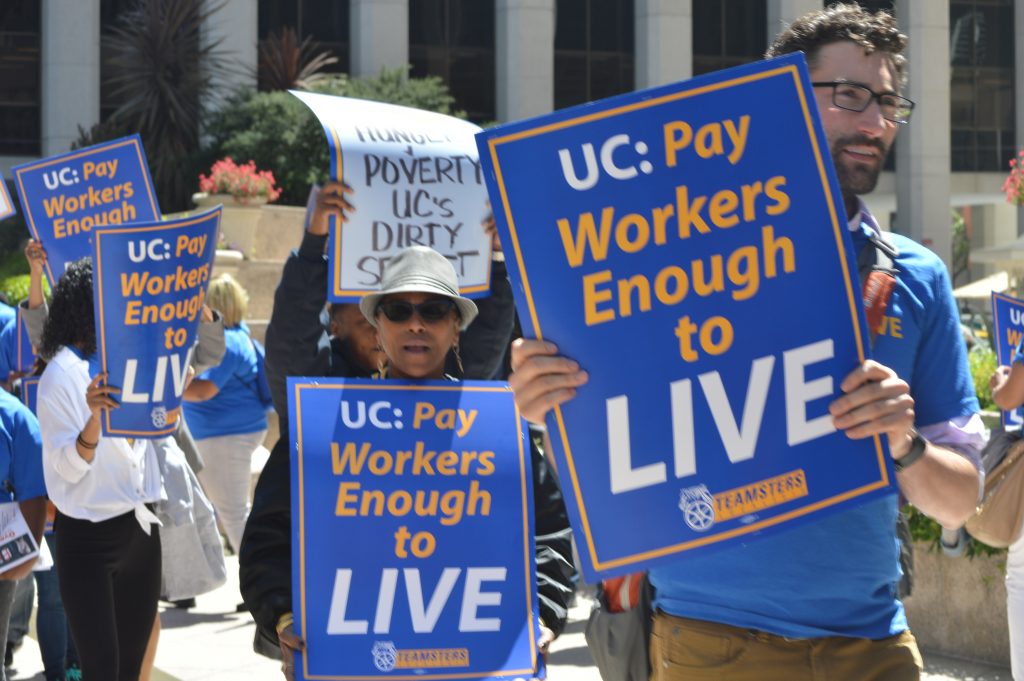
Local 2010 organizes workers at 10 UC campuses around Califonia
That effort began first with a campaign Rome initiated to affiliate clerical workers from throughout the University of California system into our union, which led to the formation of Teamsters Local 2010. That Local continues to grow and is now organizing at the California State University system as well.
On the political front, we also went right into action for the November 2010 election. Rome started out our campaign in August, visiting over 300 worksite political coordinators, shop stewards, and union officers at meetings in Stockton, Sacramento, Fresno, Modesto, and two in the Bay Area. We pulled members off the clock from eight Local unions. The team hit over 200 barns from Redding down to San Jose and throughout the Central Valley, distributing information, registering people to vote, and signing up members for DRIVE (Democrat, Republican, Independent Voter Education), the Teamsters Political Action Committee. We purchased 14 laptops and installed a phone bank, making almost 10,000 phone calls to members throughout the Joint Council. Together, we pulled over 225 volunteer phone and precinct walking shifts. This translated into big wins at the ballot box on Election Day, and we were just getting warmed up.
Winning elections means more Teamster jobs
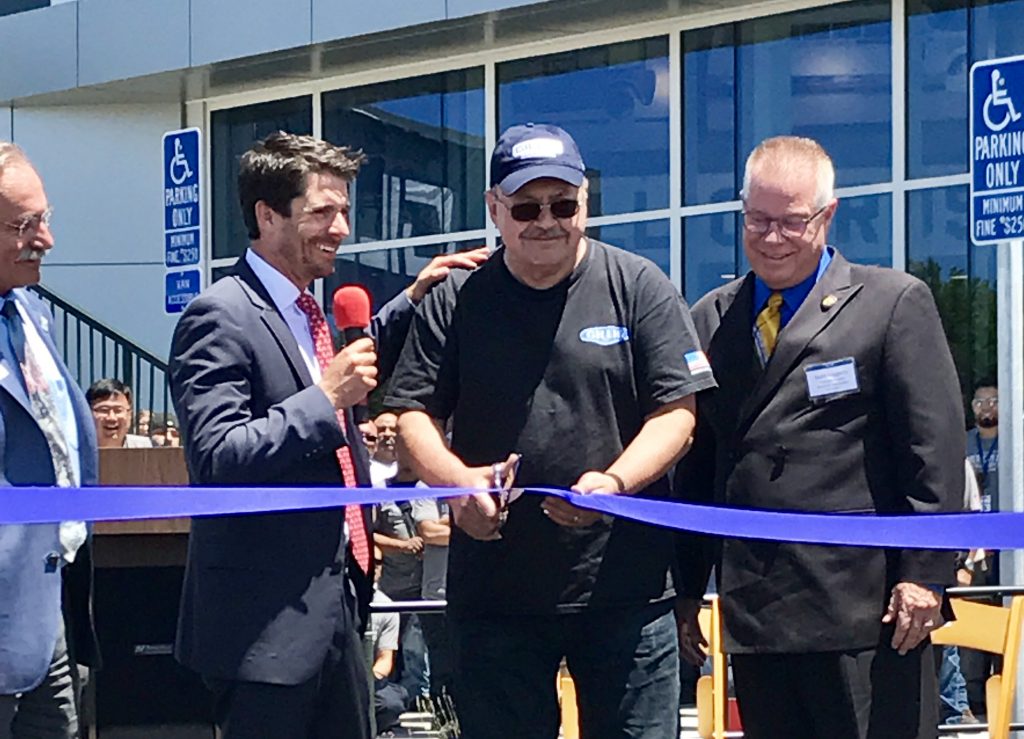
51-year Teamster member cuts the ribbon on Gillig’s new factory in Livermore.
In Patterson, where Local 386 walked precincts to help elect Mayor Luis Molina, they won an election for 613 new members at the CVS Distribution Center.
In the Bay Area, we worked to elect three Teamster-friendly members to the AC Transit Board – including the son of a retired Local 853 member. Prior to our campaign, AC Transit was using our tax dollars to buy buses from Belgium instead of from Gillig, a local company where over 600 members of Teamsters Local 853 make the last 100% made in America buses. After sweeping the election in 2010, AC Transit shifted their contract to Gillig. By 2017, AC Transit had purchased 277 buses for an approximate cost of 133 million dollars. That’s about 7 years of work for Teamster members!
Our work with Gillig didn’t stop. In 2016, states like Texas tried to lure Gillig away with the promise of subsidies to build a new plant. We went into action, working with Alameda County Supervisor Scott Haggerty — a former member of Teamsters Local 70 — to put together an incentive package that helped keep Gillig and our jobs in California. In 2017, Gillig opened their new, state of the art plant in Livermore. A 51-year Gillig employee named Stanley Alcon cut the ribbon. Together with that, we ratified a 7-year agreement with Gillig that makes our members the highest paid heavy equipment manufacturing workers in the United States.
Back to 2011. With the help of politicians in San Jose we helped elect, we beat back a proposal from the San Jose Airport to eliminate the prevailing wage for Local 665 members at the parking facilities, saving Teamsters from a likely $5/hour pay cut. Teamsters Local 287 also enlisted political support in San Jose to organize about 200 school bus drivers into our union. And out in the Central Valley, we registered over 2,000 members to vote in signed up over 500 to DRIVE.
The 2012 election – Beating back paycheck deception
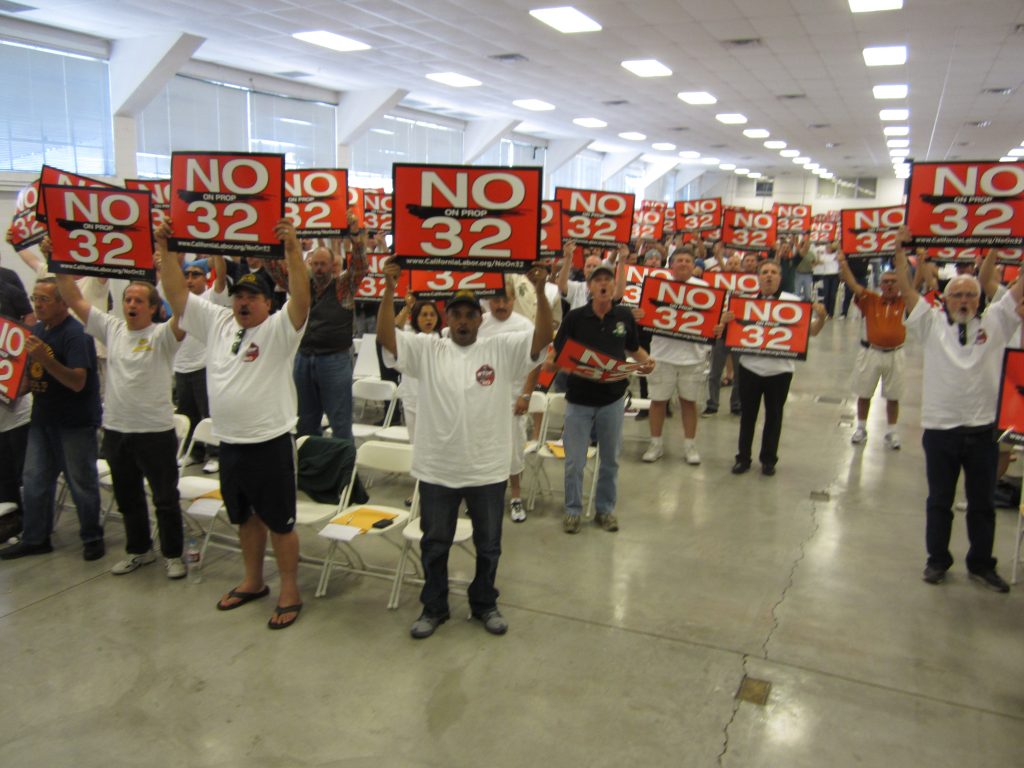
All hands on deck to fight Prop 32.
We went even bigger for the 2012 elections. In the face of the union-busting Proposition 32 ballot initiative, we ran the largest worksite political program in our history. We kicked it off in July with a meeting where we drew over 800 members from an area larger than 41 of the states in the continental US! Using the newly purchased Joint Council truck together with Local 439’s truck, we launched a three-week caravan and hit 33 work sites, talking to more than 3,000 members on the job. By Election Day, we had talked to more than 37,000 Teamsters at their worksite. Together with Joint Council 42, we registered 25,000 Teamsters to vote. In the end, over 74% of our registered members voted in the election, and Proposition 32 went down by a 57% to 44% vote. In short, we kicked their butts! The California Labor Federation – the umbrella to over 2 million union members in California – gave Joint Council 7 the “Top Performing Union” award out of all unions in the state for our worksite program against Proposition 32.
We also got more involved in local races that election, and we were quick to use that to our advantage. The first target in our sight was the California Enterprise Zone program, which was the largest corporate welfare program in the state’s history. The $750 million annual program went to the likes of WalMart, FedEx, and others for creating minimum wage jobs. We were outraged when a Teamster employer, VWR Corporation, used that money to move our jobs from the Bay Area to Visalia — leaving our members and the union behind. We flooded the Capitol in Sacramento and told our stories, taking on a giant corporate lobby. Due in a large part to our efforts, the corporate gravy train came to an end. The new program that was created, California Competes, now goes to employers that create good jobs. Several Teamster employers — including Gillig — have benefited from those funds.
Building in the Central Valley
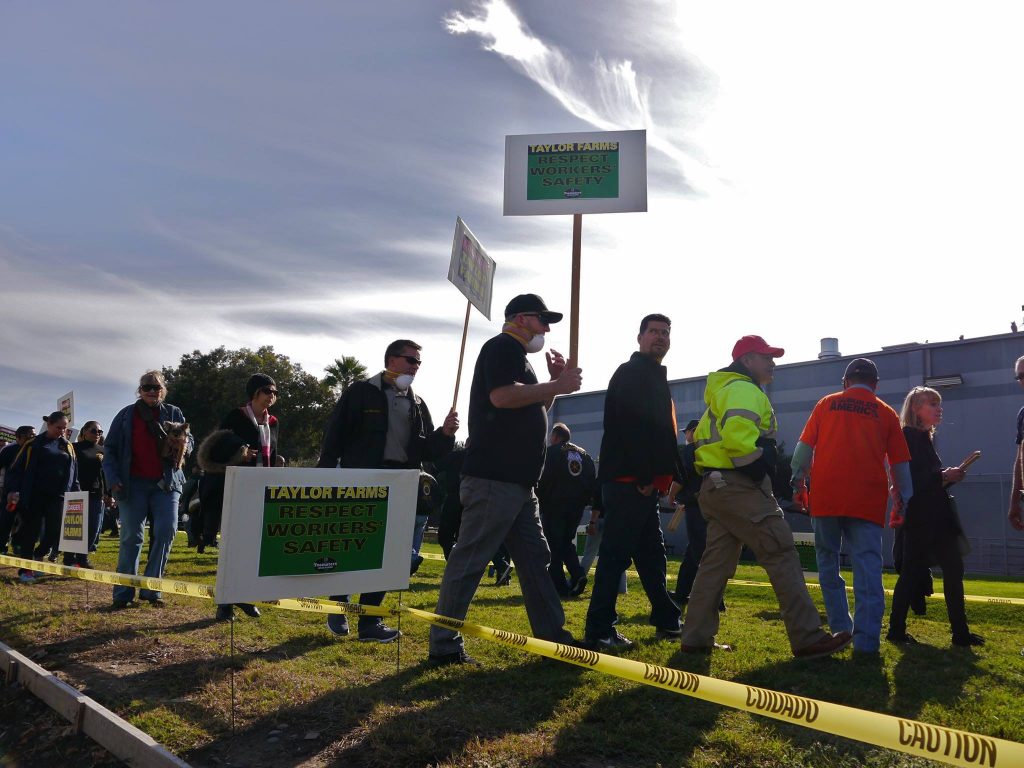
After a tainted election, the workers at Taylor Farms continued to fight for safe working conditions.
The next phase of our work focused on building up our organizing and political program in the Central Valley, an area of our state where labor has much less power. Our campaigns to organize immigrant food- and dairy-processing workers at Taylor Farms in Tracy and Marquez Brothers in Hanford showed just how stacked the deck is against workers under federal labor laws – and how workers organizing with the Teamsters could win some of the strongest labor protections in the country under state laws.
The National Labor Relations Board (NLRB), the federal agency charged with enforcing labor laws, failed the Marquez Brothers workers. After a year of delays at the bargaining table, Marquez Brothers withdrew recognition from Teamsters 517. The re-run election was further delayed by a Republican-led government shutdown, giving the employer precious more time to run an anti-union campaign. In the end, we lost the election by a handful of votes. Marquez Brothers subsequently gave workers the same wage increases we were asking for at the bargaining table.
The campaign at Marquez Brothers dairy in Hanford also exposed California legislators to the hazards immigrant workers – especially undocumented workers – face when they try and organize unions and stand up for their rights. The key word here is retaliation. When management attorneys followed workers up to a legislative hearing in Sacramento, we called them out right there in the hearing. And when one of those workers, Candi Vanegas, was fired a few weeks later, we went into action. That work resulted in the passage of AB 263 in 2013, the strongest law in the United States protecting immigrant workers from the threat of retaliation around their immigration status when they stand up for their rights at work. This success, which came with tremendous leadership from the California Labor Federation, brought national attention to our Joint Council.
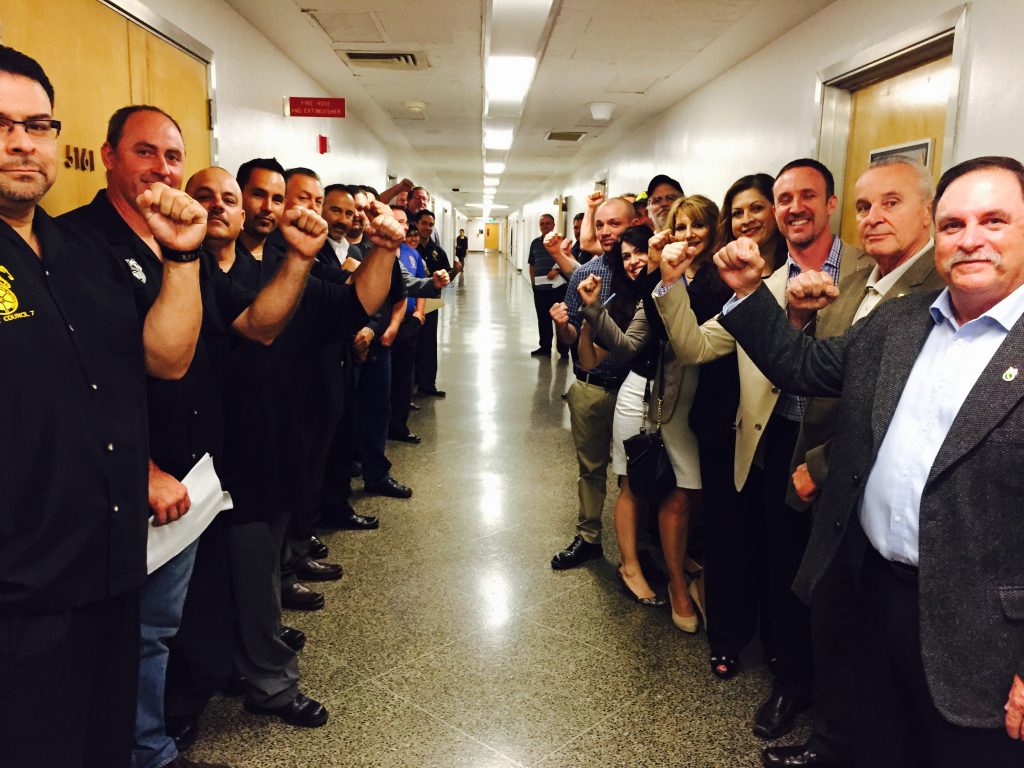
State politicians pass a gauntlet of Teamsters who want to make sure they’ll be voting right!
In another bittersweet campaign, the efforts of nearly 900 immigrant workers at Taylor Farms in Tracy to organize with Local 601 met similar results. Taylor Farms, despite over 20 years of good labor relations with Local 890 in Salinas, ran one of the most aggressive anti-union campaigns any of us have ever seen. At every step of the way, the NLRB failed the workers. Dozens of workers were fired during the campaign. It took the NLRB over a year to crack down on the employer for it. By that time, the workers were gone and the message sent to everyone else was loud and clear: stick out your neck and we will chop it off. When management brought armed thugs to the balloting locations on election day, the NLRB took the extraordinary step of sealing the ballot boxes. Again, it took the NLRB over a year to finally conclude that workers were too intimidated by Taylor Farms actions and they ordered a new election. Of course, by that time the well was poisoned and the company had successfully silenced the organizing drive.
Taylor Farms also hired half of the Tracy workers through two temp agencies. Many of the workers had been there for over a decade, so there was nothing temporary about it. When dozens of workers – including pregnant women – were injured in repeated chemical accidents, Taylor Farms and the temp agencies pointed fingers at each other about who was responsible for the workers’ compensation claims. Cal/OSHA cited both employers separately and jointly for dozens of violations, and both employers appealed.
Again, we flooded Sacramento with workers to push AB 1897, the only law in the United States that holds employers that use temp agencies liable when labor law violations occur. The Chamber of Commerce put AB 1897 at the top of their annual “job killer” list, and the Governor had never signed one of those bills. In a fight everybody said we could never win, we set up gauntlets in the Capitol for the legislators to walk through on their way to the vote. When the dust settled, we won! For all of this work, the California Labor Federation gave us the 2015 Legislative Action Award.
Capping off 2015 was getting AB 219 passed and signed by the Governor. Everyone said we couldn’t get another bill done, but we did. This bill closed a loophole in the prevailing wage law so as to cover ready-mix drivers on public works projects. Claiming that the law would increase costs astronomically, the contractors sued to shut the law down, however, the courts ultimately ruled in favor of providing a fair wage for our ready mix drivers.
Taking on Silicon Valley
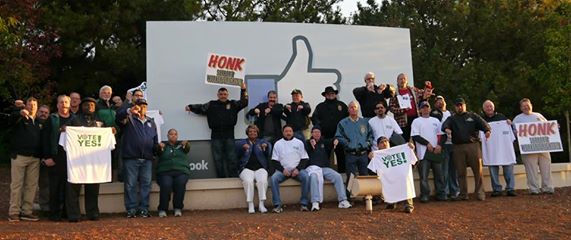
Teamsters take on Facebook to fight for the shuttle drivers.
Despite our organizing losses at Taylor Farms and Marquez Brothers, Rome kept up the relentless pursuit to organize. Under his leadership, the Teamsters took on some of the largest and wealthiest corporations in the world, turning towards our backyard in Silicon Valley. In the past few years, companies like Facebook, Apple, and Google have set up one of the largest private bus systems in the world, running tens of thousands of tech workers every day from all over the Bay Area to the high tech campuses in Silicon Valley. These tech companies contract out the work with shuttle bus companies, including many Teamster employers serving airports, transit agencies, and more.
Starting with a pioneering organizing drive with 87 contract Facebook drivers in November of 2014, Rome successfully negotiated a contract that brought our new members an average of $9/hour wage increases (from $18 to $27.50/hour), fully paid family health care, up to five weeks paid vacation and more. This effort earned national and international press for the Teamsters. Only one week after ratifying that contract, over 150 Compass Transportation drivers serving Apple, Yahoo, eBay, Genentech, PayPal, Evernote, and others joined Teamsters 853 as well.
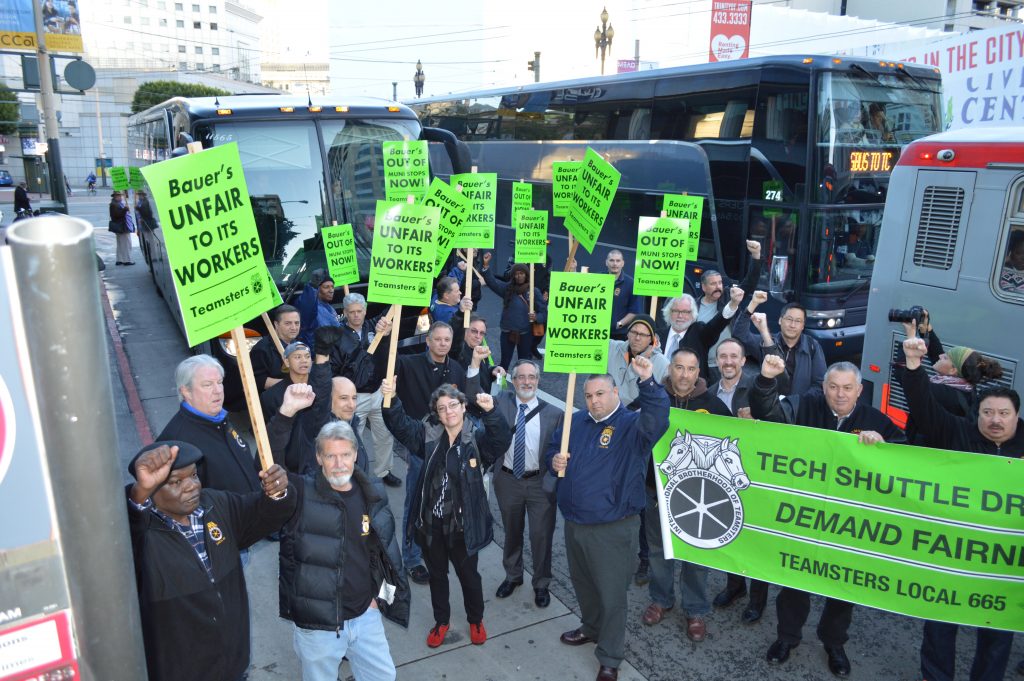
It took a city-wide effort to unionize the shuttle drivers at Bauers.
The Taylor Farms and Marquez Brothers stories proved that good organizing leads to good policy. And good policy leads to more organizing. So in that line, the Teamsters worked with the San Francisco Municipal Transportation Agency (SFMTA) to pass a permit program for the high tech shuttle buses using the public bus stops that includes a labor harmony requirement. When workers organizing with Local 665 got into a protracted fight with Bauer’s IT, hundreds of Teamsters took to San Francisco streets during rush hour, blocking Bauer’s buses. Bauer’s lost critical accounts at Salesforce and the Superbowl. The SFMTA took the extraordinary step of denying Bauer’s a permit to operate for their failure to comply with labor harmony and other program requirements. Shortly after, Local 665 negotiated a card check with Bauer’s, and over 40 of their drivers joined the Teamsters in 2016. Bauer’s is now one of our best shuttle bus employers.
In 2017, with a push from the Teamsters, the Santa Clara County Valley Transportation Authority (VTA) followed the SFMTA’s lead and adopted a similar permit policy including the labor harmony provision.
Along the way, Local 853 organized roughly 200 drivers for WeDriveU and Local 665 organized 215 drivers for Chariot. Rome had the vision to match all of the economics in every contract, setting a wage and benefit floor for the drivers.
In proof that a rising tide lifts all boats, wages for bus drivers have risen by approximately 25% in the entire Bay Area. For example, with strong political support from the San Francisco Board of Supervisors, Local 853 negotiated 44% wage increases for paratransit bus drivers in San Francisco.
Keeping up the attack in California despite anti-union victories nationally
The 2016 election also saw Joint Council 7 step up our political program again, setting new heights. Back in 2010, we made endorsements in all federal and state races, but only 20 endorsements in local races such as county supervisors, city council, and school board. Those politicians make choices on things that impact our contracts, our communities, and our families. In 2016, we made over 200 endorsements in local races – a 900% increase! And we won in over 70% of the races.
All things looked good for us in California until we saw the Republicans takeover over the White House and Congress. Newspapers across the country declared it the death of the Labor movement. The Congress and the NLRB under President Trump have systematically attacked critical policies workers and unions won, including the same sort of joint employer liability we won at Taylor Farms — but this time for organizing and collective bargaining. That ruling came from a Local 350 organizing campaign against Republic Services and their temp agency in San Jose.
So while the winds from Washington DC are blowing bad for unions, Joint Council 7 has kept up the attack. We’ve organized over 4,000 workers since the November 2016 election. That includes over 1,000 public employees in Butte County by Local 137, over 400 workers solid waste and recycling at Recology in Santa Rosa by Local 665, more than 1,800 workers at West Contra Costa Unified School District by Local 856, and over 1,200 skilled trades workers in the California State University system by Local 2010.
This year, with the balance of power at the U.S. Supreme Court swung against us by Trump’s appointment of Judge Neil Gorsuch, we expect the rise of the so-called “right to work” in the public sector. This will be one of several blows aimed to cripple workers and labor unions and put more power and money into the hands of the 1%. Under Joint Council 7 President Dave Hawley and our Executive Board’s leadership, we are working on a legislative, organizing, and communications plan to face that and other threats.
Similarly, Joint Council 7 has me spending a lot of time on the coming waves of technology and automation. This means autonomous vehicles, including driverless trucks. With predictions of 4 million workers losing their jobs in the next 20 years, this work is critically important. It is front and center in our negotiations with United Parcel Service. As with everything else, we are running a coordinated organizing, political, and policy program. Our members deserve nothing less.
By Doug Bloch, Joint Council 7 Political Director
January 2018/Rev. January 2021
